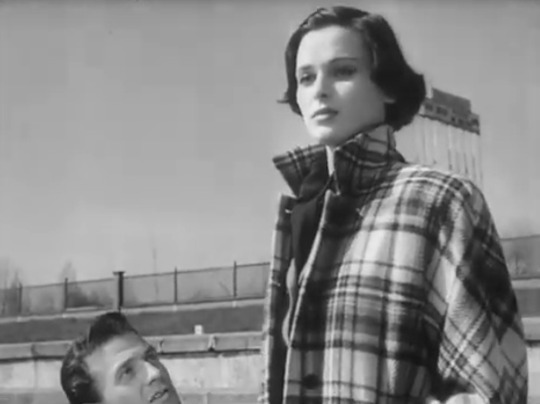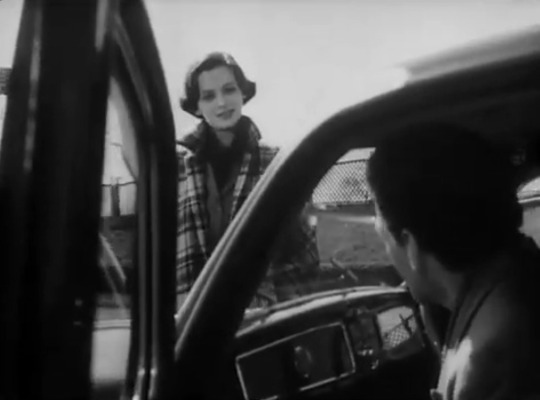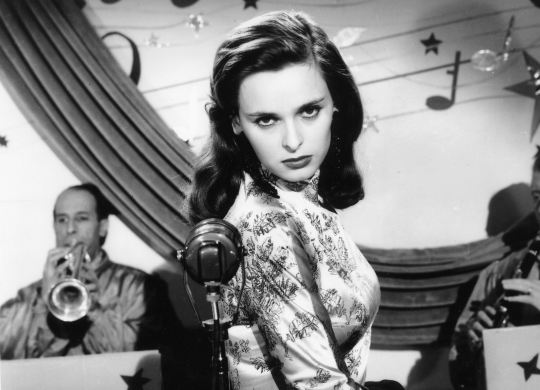#Lucia Bosé
Photo

Michelangelo Antonioni
- The Lady Without Camelias / La signora senza camelie
1953
#michelangelo antonioni#the lady without camelias#la signora senza camelie#italian film#1953#lucia bosé#lucia bose
156 notes
·
View notes
Text

Raf Vallone-Lucia bosé "No hay paz bajo los olivos" (Non c´è pace tra gli ulivi) 1950, de Giuseppe de Santis.
25 notes
·
View notes
Text
youtube
Happy Birthday!!!
#lucia bosé#lucia bose#lucia bosè#italian cinema#italian actress#neorealism#cinema#michelangelo antonioni#la signora senza camelie#Roma ore 11#Muerte de un ciclista#Cronaca di un amore#Non c'è pace tra gli ulivi#1950s#Youtube
2 notes
·
View notes
Text
youtube
cronaca di un amore, michelangelo antonioni 1950
*








#cronaca di un amore#michelangelo antonioni#1950#lucia bosé#massimo girotti#al di là delle nuvole#i vinti#stromboli#viaggo in italia#rossellini#bergman#miss italia#die schauspielerin#agatha et les lectures illimitées#death of a salesman#about photography
0 notes
Text

Lucia Bosé (Non c'è pace tra gli ulivi - 1950)
#art#photography#film#cinema#movie#photooftheday#woman#cult#peace#peasants#olive trees#lucia bosè#italian cinema
19 notes
·
View notes
Text

Died on this day: talented, sensitive and exquisite Italian actress Lucia Bosé (28 January 1931 - 23 March 2020). After winning the Miss Italia beauty pageant in 1947 (she beat a young unknown Gina Lollobrigida!), Bosé became a major star of mid-twentieth century Italian neo-realist cinema, working with the likes of Federico Fellini, Luis Buñuel and Jean Cocteau, and was half of a glamorous celebrity couple during her stormy marriage to Spanish matador Luis Miguel Dominguin between 1955 - 1967. Truthfully, I only know Bosé from the two films she made with her then-lover, visionary director Michelangelo Antonioni: Story of a Love Affair (1950) aka Cronaca di un amore and The Lady without Camellias aka La signora senza camelie (1953), (pictured) but she makes a vividly haunting and melancholy impression in both (her sultry dark looks anticipate Isabella Rossellini or Natassja Kinski).
#lucia bosè#michelangelo antonioni#italian actress#italian cinema#european art cinema#lobotomy room#The Lady without Camellias#La signora senza camelie
12 notes
·
View notes
Text

METELLO SCREENCAPS
Metello is a 1970 Italian drama film directed by Mauro Bolognini, based on Vasco Pratolini’s novel. It was entered into the 1970 Cannes Film Festival.
Plot (it may contain spoilers)
Metello struggles to escape from the poverty that led to the premature death of his parents, and that is the lot of the working class in northern Italy during the second half of the 19th century. Metello fights his way out from his condition through hard work, a determined will to resist oppression inherited from his father, but also by taking advantage of his good looks when dealing with women. Metello progressively assumes an important role in the organization of an emerging workers movement, and attempts to conciliate his risky political activities with his private life.
Cast
Massimo Ranieri - Metello
Ottavia Piccolo - Ersilia
Frank Wolff - Betto
Tina Aumont - Idina
Lucia Bosé - Viola
Pino Colizzi - Renzoli
Mariano Rigillo - Olindo
Luigi Diberti - Lippi
Manuela Andrei - Adele Salani
Corrado Gaipa - Badolati
Adolfo Geri - Del Bueno
Claudio Biava - Moretti
Franco Balducci - Chellini
Steffen Zacharias - Pallesi
Sergio Ciulli
The film was released on 10th March 1970.
#Tina Aumont#Massimo Ranieri#Mauro Bolognini#Metello#1970 Metello#Ottavia Piccolo#actress#my screencaps
6 notes
·
View notes
Photo

Alberto Closas and Lucia Bosè in Death of a Cyclist (Juan Antonio Bardem, 1955)
Cast: Lucia Bosè, Alberto Closas, Otello Toso, Bruno Corra, Carlos Casaravilla, Manuel Alexandre. Screenplay: Juan Antonio Bardem, Luis Fernando de Igoa. Cinematography: Alfredo Fraile. Film editing: Margarita de Ochoa. Music: Isidro B. Maiztegui.
Often cited as a landmark in Spanish cinema, Death of a Cyclist is notable for the way director Bardem (uncle of the actor Javier Bardem) manages to slip a satiric look at the Spanish upper classes past Franco's censors by tucking it into a suspense thriller. He often does this by startling jump cuts: The protagonist, Juan (Alberto Closas), looks down into the courtyard of a slum, but what we see are people attending a society wedding. The gossip Rafa (Carlos Casaravilla) angrily throws a bottle, but the window that breaks is miles away at the university where a student protest is taking place. The film is full of linkages like this, including the fact that Juan bears a striking resemblance to the man he is cuckolding, Miguel (Otello Toso). Sometimes, of course, Bardem and his co-scenarist Luis Fernando de Igoa make their satire more explicit, as when a society woman says she's supporting a charity "for poor children, or maybe for stupid children." Her distance from the objects of her charity is a comic twist on the distance that allows María (Lucia Bosé) to persuade Juan that they should leave the scene after they run down a cyclist on a lonely road at night: They are having an affair, and she doesn't want to get caught. Bardem doesn't show the actual accident or even the body of the cyclist (who is still alive after they leave the scene), leaving us to judge the couple as their guilt begins to mount -- even though they are never in any danger of being accused of the hit-and-run crime. The film continues to unfold as a saga of crime and self-punishment, made richer by Bardem's careful manipulation of point of view.
4 notes
·
View notes
Photo

Lucia Bosé (1931-2020) by Truus, Bob & Jan too! Italian postcard by Bromofoto, Milano, no. 270. Today, 23 March 2020, Italian actress Lucia Bosé passed away in Brieva, Spain. She died of pneumonia caused by the coronavirus. Bosé was famous for her films from the 1950s with a.o. Giuseppe De Santis and Michelangelo Antonioni. In the same years and after she also worked with other famous directors such as Juan Bardem, Luis Buñuel, the Taviani brothers, Liliane Cavani, Francesco Rosi, and Ferzan Özpetek. Lucie Bosé was 89. Lucia Bosè was born Lucia Borloni in Milan, Italy in 1931. She comes from a peasant and working-class family and began to work at the age of twelve years. She was first a messenger for a law firm, later a clerk in Milan's fine pastry shop Galli. In 1947 she participated in the first Miss Italy pageant, where she was able to win against competitors like Gianna Maria Canale, Eleonora Rossi Drago, and Gina Lollobrigida. Had Giuseppe De Santis still preferred Silvana Mangano for Riso amaro/Bitter Rice (1949), he chose Bosè for his next film, Non c'è pace tra gli ulivi/No peace among the olive trees (Giuseppe De Santis, 1950), a typical Neorealist film about a poor shepherd (Raf Vallone) who tries steal back his sheep stolen from him while he was at war. In the same year, Bosé starred opposite Massimo Girotti in the well-to-do set, modernist crime story and drama Cronaca di un amore/Story of a love affair (Michelangelo Antonioni, 1950). It was Antonioni's first full length feature film, about an adulterous couple plotting to kill her husband. Numerous screen engagements followed. Antonioni cast her again in La signora senza camelie/The Lady Without Camelias (Michelangelo Antonioni, 1953) about a newly discovered starlet and her experiences in the Italian cinema. Juan Bardem cast her in Muerte di un ciclista/Death of a Cyclist (1955) about an adulterous couple that runs over a cyclist and leaves him to die. Bosé also acted in Francesco Maselli's debut Gli sbandati/The Abandoned (1955) and Luis Buñuel's Cela s'appelle l'aurore/That Is the Dawn (1956). In 1955 Lucia Bosè married Luis Miguel Dominguín, a five years older, popular Spanish bullfighter and occasional actor. From the marriage, which ended in divorce in 1967, sprang three children, two of whom - Paola Dominguin and Miguel Bosé - are also active as actors. Luchino Visconti was godfather to her son Miguel, Pablo Picasso to her daughter Paola. At the time, Lucia Bosè lived in Spain and put her career on halt, except for a sporadic appearance in Le testament d'Orphée/Testament of Orpheus (Jean Cocteau, 1959). In 1968 Bosé returned to film acting after almost a ten-year break and worked first in Spain and afterward in Italy. There she worked among others in Federico Fellini's Satyricon (1969), the Taviani Brothers' Sotto il segno dello scorpione/Under the Sign of Scorpio (1969), and Liliana Cavani's L'ospite/The Guest (1972). Other interesting films with her were Nathalie Granger (Marguerite Duras, 1972), Lumière (Jeanne Moreau, 1976) and Violanta (Daniel Schmid, 1977). After 1978, she acted significantly less but remained active, also on television. She had memorable film performances in Cronaca di una morte annunciata/Chronicle of a Death Foretold (Francesco Rosi, 1987) starring Rupert Everett, El niño de la Luna/Moon Child (Agustí Villaronga, 1989), Harem suaré/Harem (Ferzan Özpetek, 1999) and I vicerè/The Viceroy (Roberto Faenza, 2007). Her most recent screen appearance was in Alfonsina y el mar/One more time (Pablo Benedetti, David Sordella, 2013), as an 80-year-old actress who returns to the small Chilean town of her youth to fulfill her father's dream of creating a TV channel in a place which has never known television. Sources: CinéArtistes (French), Wikipedia (German, English, and Italian) and IMDb. https://flic.kr/p/2iH3q9T
13 notes
·
View notes
Text

Marcello Mastroianni-Lucia Bosé "París, siempre París" (Parigi è sempre Parigi) 1951, de Luciano Emmer.
2 notes
·
View notes
Text


Lucia Bosè in Tradita (1954)
1 note
·
View note
Text

Escândalo de Amor
I, 1950
Michelangelo Antonioni
7/10
Castelos no Ar
Esta Cronaca di um amore, que em português se chamou Escândalo de amor, sem que nenhum escândalo exista no filme, salvo talvez no moralismo do censor, é a primeira longa metragem assinada por Michelangelo Antonioni, datada de 1950. Antes dela só tinha realizado curtas metragens.
Conta com a atriz fetiche dos seus primeiros filmes, Lucia Bosè, sempre bela, magnífica, no esplendor dos seus dezanove anos, carismática, e um argumento que vai buscar inspiração ao film noir americano, seguindo a moda da época.
Mas nas mãos de Antonioni o film noir transforma-se num drama psicológico. Os personagens são visceralmente capazes de tudo, mas têm remorsos, e a conclusão inevitável do filme é a de que é impossível construir o que quer que seja, em cima do remorso, mesmo quando a culpa não exista, ou decorra de mera omissão.
Uma referência ainda à magnífica banda sonora de Giovanni Fusco, interpretada ao piano por Armando Renzi e ao saxofone por Marcel Mule. Misteriosa, tensa, minimal, contribui enormemente para a densidade dramática do filme.
Uma estreia auspiciosa de um dos realizadores mais importantes da sua geração.
Castles in the Air
This Cronaca di um amore, which in Portuguese was called Escândalo de amor, without any scandal in the film, is the first feature film signed by Michelangelo Antonioni, dating from 1950. Before it, he had only made short films.
It features the fetish actress from his first films, Lucia Bosé, always beautiful, magnificent, in the splendor of her nineteen years, charismatic, and a script that draws inspiration from American film noir, following the fashion of the time.
But in Antonioni's hands, film noir becomes a psychological drama. The characters are viscerally capable of anything, but they have remorse, and the inevitable conclusion of the film is that it is impossible to build anything on top of remorse, even when guilt does not exist, or arises from mere omission.
A reference also to the magnificent soundtrack by Giovanni Fusco, played on the piano by Armando Renzi and on the saxophone by Marcel Mule. Mysterious, tense, minimal, it contributes enormously to the dramatic density of the film.
An auspicious debut from one of the most important directors of his generation.
0 notes



